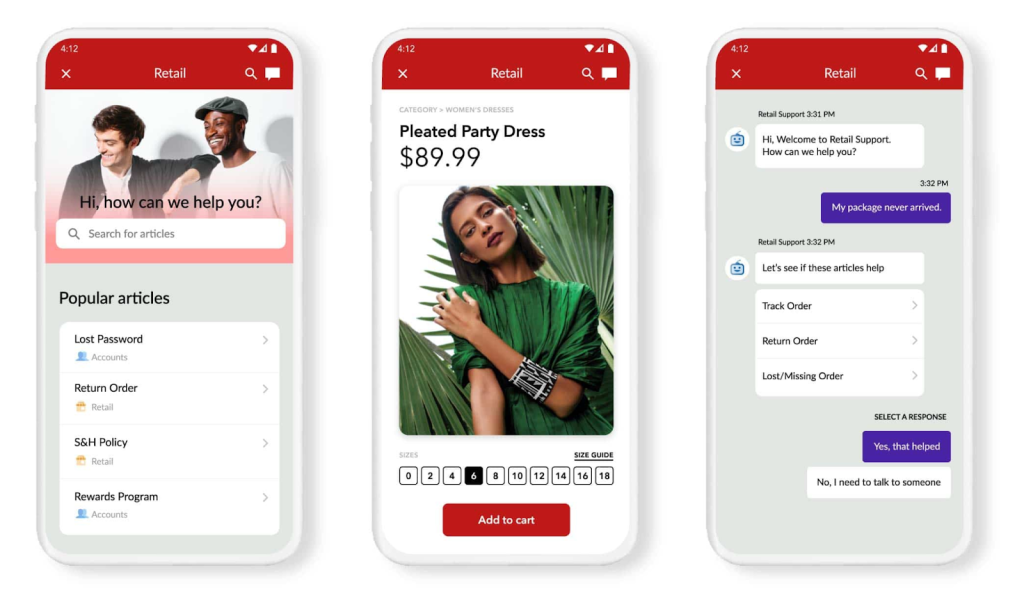Chatbots today should not be conflated with chatbots of the past: the technology is more advanced and the customer experience is likewise enhanced. Historically, the opportunity cost of a poor experience due to chatbots often outweighed the cost reduction component due to ticket deflection. But thanks to improved artificial intelligence and machine learning capabilities, chatbots today are instrumental for streamlining and optimizing customer service operations.
While we might be preaching to the choir here, implementing new technology is rarely a solo decision. To help you build a solid business case for implementing chatbots that will resonate with decision-makers, we’ve compiled some helpful stats and top benefits that will help you show that chatbots are a no brainer for your brand.
First, what’s a chatbot?
It may seem obvious, but in case you’ve never interacted with a chatbot before, here’s how we define it at Helpshift. A chatbot is a computer software program, typically driven by artificial intelligence (AI), which allows a customer to communicate with a company or brand in a text format that simulates instant messaging between humans. Chatbots are found on company websites as well as in mobile applications and social media messaging apps. Chatbot technology has advanced considerably in recent years thanks to improved AI and machine-learning capabilities, and today’s chatbots are a critical component to companies’ customer-service operations.
Chatbots by the numbers
- 37% of customers say they would prefer to get immediate assistance from a chatbot over waiting just three minutes for a human.
- 55% of customers say they would welcome the idea of chatbots in the customer service process.
- 73% of customers say that valuing their time is the most important thing a company can do to provide them with good online customer service.
- 48% of consumers have interacted with a chatbot in the past year for customer service inquiries.
- 65% of millennials want chatbots involved in the customer service process.
The top 5 benefits of chatbots for customer service
While numbers are great, a business case for chatbots also needs to spell out the benefits to the business in terms of cost savings and improved processes for consumers and agents. Here are what we consider to be the top five benefits of adding chatbots to your customer service offerings.
1. No Wait Time
This is probably the most obvious benefit of chatbots, but it remains vitally important nonetheless when it comes to optimizing the customer experience. Customers simply do not like to wait for help—any wait time can lead to frustration and potential churn. At the same time, it does not make fiscal sense to have an oversupply of live agents waiting to respond to each incoming chat instantaneously. Chatbots are a smarter way to ensure that customers receive the instant response that they demand.
2. Minimized Agent Transfers
An additional benefit of chatbots is that they classify issues to help route tickets to the right agent the first time. Having a live person answer the initial query and then manually categorizing (and especially assigning) the ticket takes time. A chatbot combined with automated routing can take care of this process accurately and instantaneously, thus reducing the time and cost associated with transferring a customer between different departments.
3. Quicker Issue Resolution
Providing an immediate response is valuable, but having an expedited resolution is arguably even more important to the customer. Customers don’t just want to be heard, they want action—quickly. With chatbots collecting information about the customer and issue ahead of time, agents will be armed with all the data they need to most efficiently resolve the issue. An additional benefit is that if the agent has follow-up questions, the customer can answer in real time as well (as opposed to having to wait around if they are inquiring through a different channel like email).
4. Improved Self-Service
Self-service is nothing new, but when layered with machine learning and the chatbot interface, it adds a new level of incredible value. Historically, chatbots have received a bad rap for inaccurately routing and responding to customers. But with machine learning and improved data, chatbots can more efficiently direct customers to answers that will actually help them. This will simultaneously increase both ticket deflection rates and customer satisfaction.
5. Cost optimization
Yes, chatbots help reduce costs by reducing manpower. But it goes beyond cost reduction. According to a recent Forrester report, enterprises should focus on cost optimization instead, as “companies that take advantage of chatbots’ larger cost optimization opportunities can”:
- Bring scale with chat concurrency
- Automate end-to-end business processes
- Enable new customer service models
Conclusion
Ultimately, chatbots can and should be utilized to create a better experience for the customer, agent—and brand as a whole. Armed with your new knowledge about chatbots, you should be ready to make a strong business case for implementation. To get started with chatbots, learn more here, or check out our beginner’s worksheet for building customer service bots.
Want to learn more?
- Customer Service Glossary Article: What is a Chatbot?
- Additional Product Information: Helpshift Customer Service Bots
- Additional Product Information: Helpshift AI Capabilities





